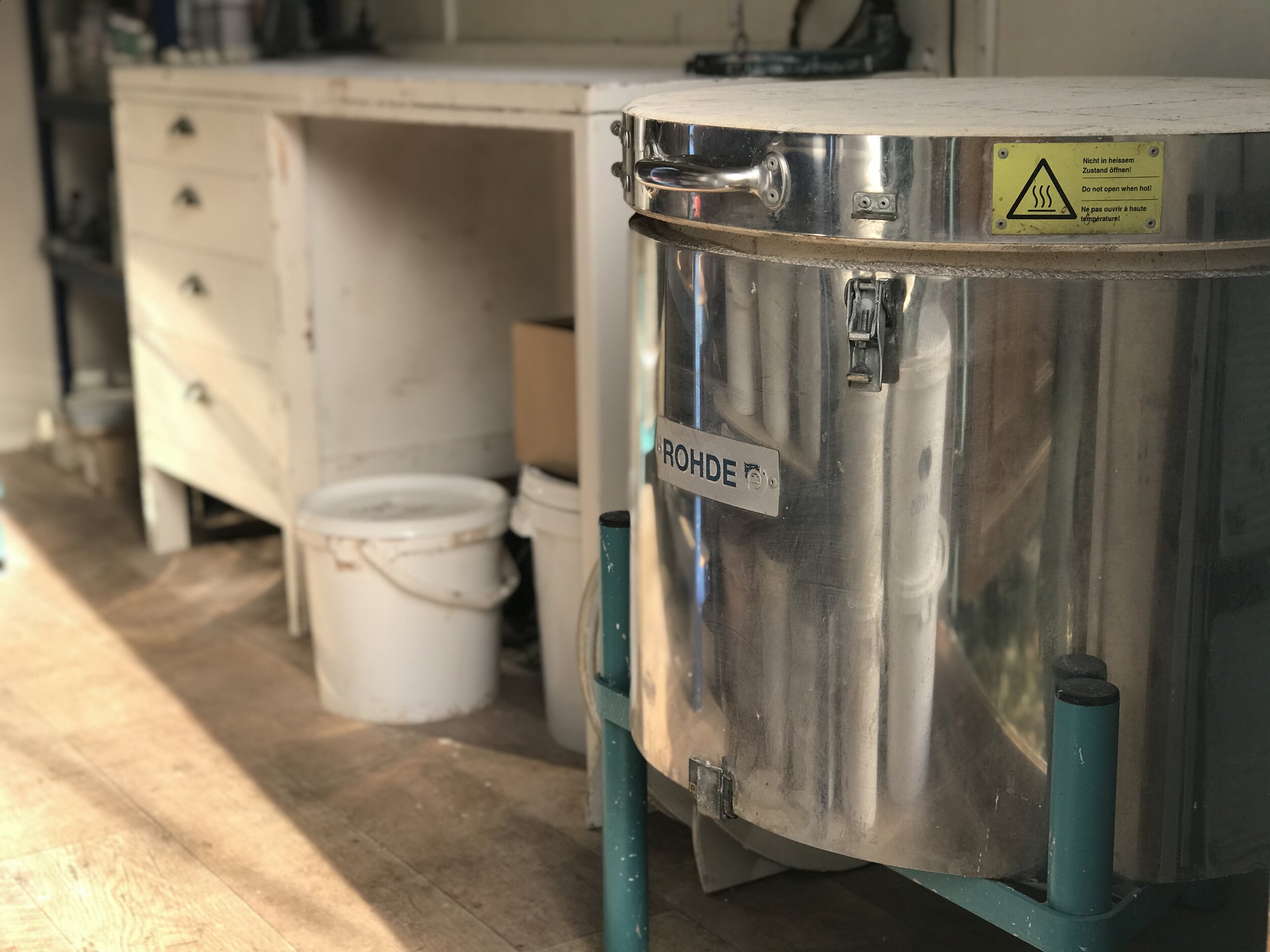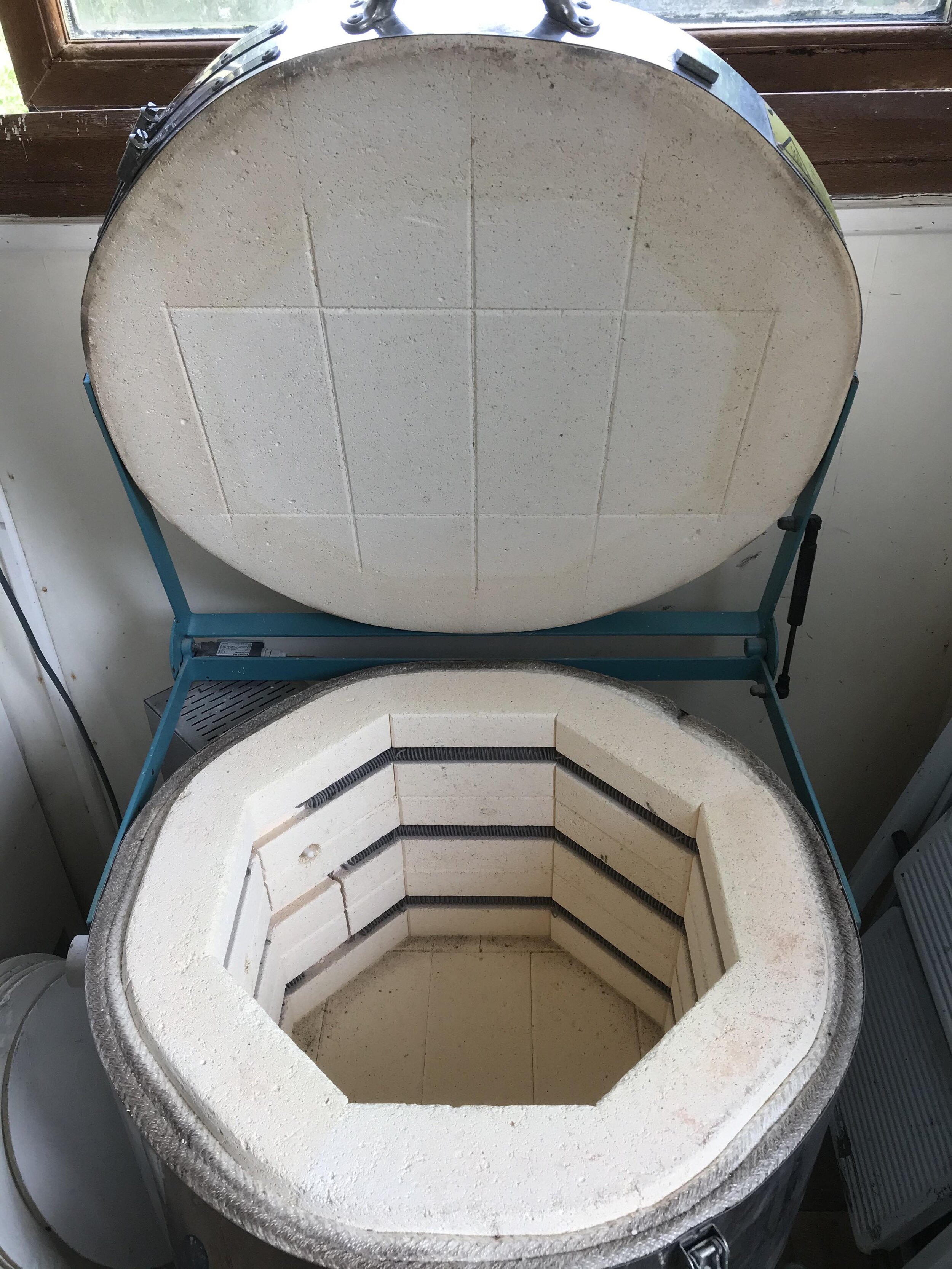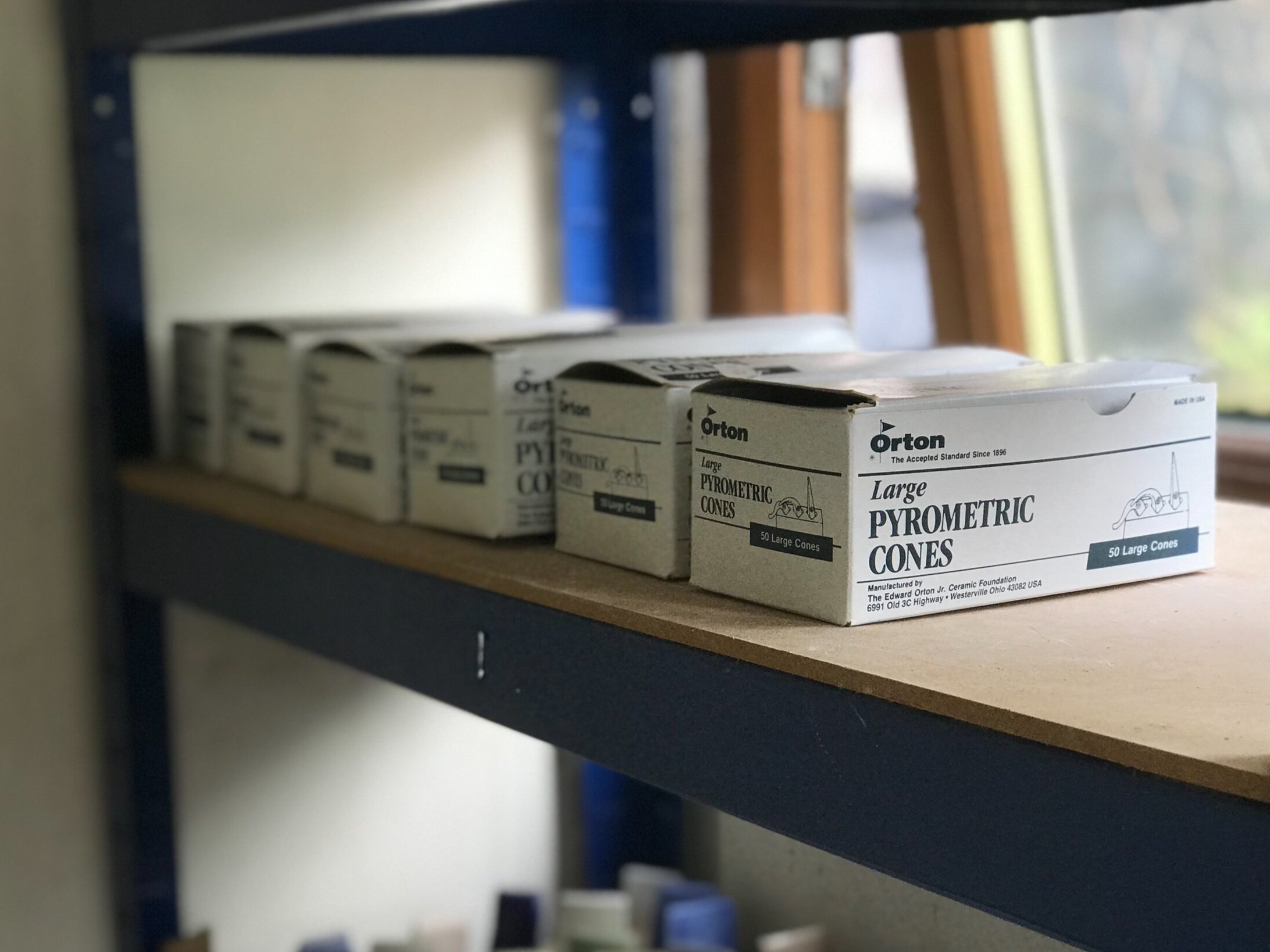Choosing a Pottery Kiln
Imagine, not having to wait for a community studio to fire your work… Imagine, having more control of your firing results…
Rohde 45 litre Eco Top Loading Kiln
If you are considering pottery becoming a side hustle or a career or just taking your hobby to the next level then you will need a kiln of your own.
Buying your own kiln can be a slightly intimidating stage of a potter’s journey but if a few key things are considered and the kiln is used correctly they can be perfectly safe and become a potter’s best friend. Many potters even name their kilns because they are such a crucial part of their studio, they spend so long becoming acquainted with them they feel like friends. (My kilns are called ‘Big Derek’ and ‘Little Derek’ - if you were wondering😉.)
Most kilns are powered by electricity or gas (wood, oil and solar are also options but they tend to be trickier). If you’re a newbie to pottery I’d recommend electric kilns to be the best place to start as they are relatively easy to use, they are economical to fire, they’re greener and come in a range of sizes which make them more affordable and easier to locate in your creative space. Many people think firing a kiln must be expensive, but in fact modern kiln technology means they are so efficient they are surprisingly inexpensive to fire.
Interior of my small kiln with super insulating 3 inch kiln bricks.
Kilns are a big investment, it will be with you for a long time so it's important to get it right. These are the top questions I get asked by folks who are looking to buy their first kiln:
Should I buy new or second hand? Kilns tend to last a really long time so it is perfectly possible to buy them second hand. Here are some questions you might want to ask a seller:
‘How old is the kiln?’ Knowing the age of the kiln, comparing it to the listing pictures can give you an indication if it has been well looked after or if it’s been abused.
‘What is its top temperature?’ It is important to know that the kiln you are looking at can reach stoneware temperatures. Many second hand kilns are advertised as only reaching earthenware temperatures.
‘When were the elements last changed?’ Knowing this will enable you to roughly estimate when you might need to change them. Elements normally last up to 100 firings (this does vary depending on factors such as firing temperature and glazes used) You don’t want to spend £££ on a kiln for which you will need to change the elements two weeks later.
‘Does it come with a controller or is it manual?’ If you are used to kilns powdered by controllers, a manual kiln will be an additional learning curve. Manuals are perfectly fine but just make sure you know what you are getting.
‘Where has it been stored?’ If it has been stored well, an older kiln can work as well as a newer one. If it has been stored outside or in a damp place it may have corrosion. Ask for pictures of the outside casing, the door/lid hinges and the circuit board.
‘Is there any damage to the bricks?’ Check for loose bricks - you don’t want them falling onto your work. Cracks are normal and to be expected as long as they don’t go all the way across and/ or all the way through the base or the lid.
117 litre Rohde TE-S Kiln
How big should my kiln be?
This will depend on three main factors: budget, space, and how big your work is (individually and cumulatively). Kilns can be either front loading or top loading. Front loaders - where the door is at the front - tend to be bigger and much more expensive. Top loaders - those with a lid which opens at the top (the type I have) come in many different sizes, tend to be more affordable and you can normally find one to fit any space.
You may be a hobby potter right now but would you like it to become a full-time gig one day? Will you always be making small items or are you likely to want to create larger forms one day? Not sure? My top advice would be, if you're not sure - don't limit yourself. If you think you might want pottery to become your side hustle or even a full time job it would be worth investing in the right kiln now rather than having to pay twice upgrading to a bigger kiln later on.
Kara’s Kiln Shed
Where should I put my kiln?
A garage, outhouse, basement, conservatory, utility room, even a dry lean-to, would all be good places to locate your kiln. The main thing is that the kiln needs to be isolated from your living space . Having a kiln in a wooden shed is fine but it needs to be at least 18 inches away from walls, floor or indeed anything else combustible whilst firing. It is a good idea to put concrete or patio slabs on the floor beneath the kiln if possible. I have two kilns both situated in an external 12 x 6 ft wooden shed (the stripy building in the pic above). This building was already here when we bought our house so I don't have much info on its construction but what I can tell you is that it is wood and it's insulated. I'm not too sure what the exact material of the floor is but it's wooden boards of some kind with vinyl on top. Both of my kilns are on stands raised 1 - 1 1/2 foot off the floor, they are not on blocks or slabs at the moment but the floor doesn’t get too hot (I’ve checked!). My little kiln (45 litres) is on wheels so it can be rolled out when it’s firing and stored out of the way when not in use - so a slab isn’t really an option here. I was nervous about the weight of my big kiln (117 litres) being full of work, kiln shelves etc as that is heavy! but it hasn't fallen through the floor yet 😂🙈 😬 (I may look into getting it onto some small patio slabs soon though😬) It is super important that the kiln is located where no pets or children can EVER access the kiln. I always put a padlock on my kilns whilst it’s firing.
Will I need to vent my kiln?
If there is poor or no ventilation in your space or your kiln is situated where you work/ live it will need to be ventilated to the outside. My kilns aren't vented because I don’t work in the shed when they are on. I use a hook on the door which keeps it open ajar when the kilns are firing. There is plenty of air flow in my shed - there are windows down one side which are always open so the fumes have dissipated before I go in to unload. You can buy venting kits from kiln retailers.
Most modern kiln controllers have a safety feature on them which automatically shuts them off if the ambient temperature of the room goes above 45 - 50 degrees centigrade - this is so the circuits don't get fried. Even here in the UK, when our summers don't get much past 30 degrees C my shed gets pretty hot and has flipped it off once or twice. I sometimes will use a fan to help extract the hot air. If you are in a hot country you’ll need to get a venting system to help keep the ambient temperature of the room down, even if you don’t work near your kiln,
Always use pyrometric cones in your glaze firings.
Will my kiln need to be wired in?
Some smaller kilns can plug straight into a socket (like a kettle.) My 45 litre Rohde came with a 13 Amp plug and plugs straight in. Larger kilns will need to be hard wired in - you will need an electrician to do this for you, they will also be able to check your breaker box, voltage and other safety elements at the same time to make sure the kiln won’t cause any issues. This isn’t as big a job as you may think and any good electrician can do it. I chose to get my small kiln hardwired in at the same time as I got my large kiln wired in as this helps the elements last a bit longer.
But aren’t kilns power hungry and expensive to fire?
Newer kilns have super-duper insulation meaning they can get up to stoneware temperatures using surprisingly little electricity. My large 117 litre kiln costs approx £6 to fire.
What safety considerations do I need to take into account when buying a kiln?
Kilns reach temperatures of up to 1300 degrees centigrade and must be respected. Kilns are a serious piece of equipment but - if used correctly and with care - are completely safe. Obviously the outside of a kiln does get extremely hot and as I said previously fumes are an important consideration so you need to make sure the kiln is vented properly or in a well insulated area sealed off from living or working space and never situated within reach of children or animals. Always situate a kiln in a suitable area; on a concrete floor or patio slabs is best and at least 18 inches away from walls or other furniture. Always use a stand for your kiln to raise it off the floor. Kiln firings need to be carefully supervised. Take extra care when working around a hot kiln.
Never fire an unvented kiln in a closed room or in close proximity to people or animals.
Never put anything on top of a kiln even when it is off! get into the habit that nothing goes on top of your kiln EVER.
Never lean items against a kiln even when it is not firing.
Clear any combustable materials from around the area where a kiln is located.
Make sure any kiln which needs wiring in is done by a professional electrician.
Always put a padlock on a kiln if possible whilst it is firing.
Supervise your kiln closely whilst it is firing and cooling and especially around peak temperature.
Always follow all kiln manufacturer’s instructions in regard to usage.
Never open a kiln unless it is a room temperature.
It’s always wise to have a fire extinguisher near by.
Kilns aren’t as scary as you might think but they must be respected.
I hope this has helped you on your pottery journey and got you a little closer to where you’d like to be.
If you have any more questions, pop them in the comments below and I’ll answer them.
Lots of Love
Kara
PS If you enjoy my blog, find it helpful or inspiring - take a moment to consider joining my Pottery Club.
My Pottery Club is a place where I share - real time video pottery tutorials, lessons and learnings from my 15 Years of potting, PLUS limited edition work and seconds sales and in return you will be supporting your fav artist 😉- I’d love to see you there!
Duck Egg mugs fresh out of the kiln






